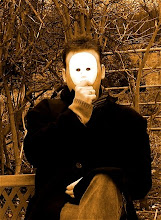
I am about to post some work that roughly correlate with Lovecraftian themes, so I thought I’d give my own interpretation/summary of H. P. Lovecraft’s works. The aim is to show people unfamiliar with his work exactly what cultural reference points I’m referring to. It’s not necessary to read this bumph, but I think it adds an element of understanding behind the work. This is the only time that I think I’ll attempt to explain my reasoning behind my work, so embrace!
Howard Phillips Lovecraft was an American horror/fantasy writer who died in the 1930’s. Clearly not as well known as Poe, Stoker, Shelley, etc., nor a particularly skilled writer, and often xenophobic in his writings (a sign of his times perhaps?). So why is he still remembered and revered? Its because of the worlds he created. Like authors such as Tolkien and Pratchett after him, he created his own grim reality (or Mythos) – peopled with strange, often galactically huge, and horrific tentacled creatures who crashed through space to Earth near the beginning of its creation. Still under the sea, these amphibian monstrosities would sometimes surface in isolated fishing ports to drag its inbred sailors and families into the murky depths, and either tear them apart or convert them to acolytes who pray to them (a bit like bible belt Christians, really). The King of these particular Earth-bound Old Ones is undoubtably the great Cthulhu. A great, giant behemoth of a creature – almost too big for this earth – who sleeps in an underwater cavern, deep in the bowels of the earth’s core, waiting for the day to rise again and destroy/enslave humanity. Among the many other colourful creatures Lovecraft created are the vicious Dagon and the mysterious Shub Niggurath - the Goat Mother With a Thousand Young (more like a tentacled cloud of flesh), and other hideous monstrosities.
Famous stories include The Dunwich Horror, which was made into a film in the 1960’s, that dealt with strange, greenish sea-folk in a remote village (who were inbred with fish-like alien ancestors). His work, though often rough around the edges and formulaic in structure, was clearly ambitious, genuinely frightening, and memorably original. As such, he has since become revered as one of America’s top cult authors of the early 20th Century – though a largely unsuccessful pauper in his own time.
I’ve been a very strong fan of his stories for the past 18 years, when I first read an article about his legacy in a sci-fi magazine (which I’ve since sold on ebay – doh!).
Please google him for more information (there’s a lot out there about his own strange life – wikipedia is a good starting point), and I strongly recommend you grab the nearest compendium of his bizarre stories from your local library.
PB.

No comments:
Post a Comment